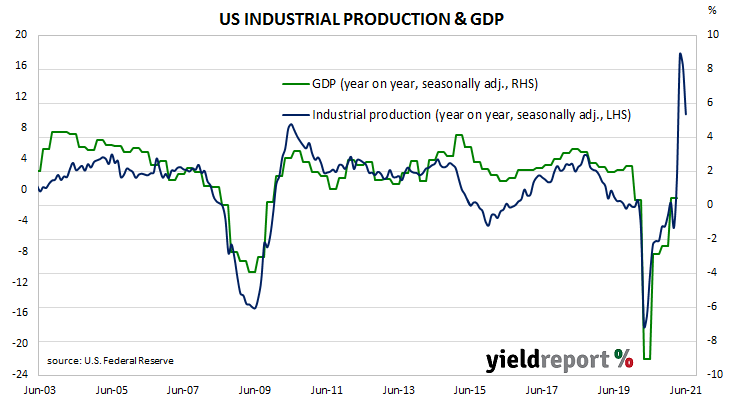Summary: US industrial output expands by 0.6% in June, up 9.8% over 12 months; rise less than expected; May figure revised down slightly; utility output & mining up, manufacturing “disappoints; capacity utilisation rate rises, still short of February 2020 figure.
The Federal Reserve’s industrial production (IP) index measures real output from manufacturing, mining, electricity and gas company facilities located in the United States. These sectors are thought to be sensitive to consumer demand and so some leading indicators of GDP use industrial production figures as a component. US production collapsed through March and April of 2020 but then began recovering in subsequent months.
According to the Federal Reserve, US industrial production expanded by 0.4% on a seasonally adjusted basis in June. The result was less than the 0.6% increase which had been generally expected and less than May’s 0.7% expansion after it was revised down from 0.8%. On an annual basis, the expansion rate slowed from May’s revised figure of 16.1% to 9.8%.
Longer-term US Treasury bond yields fell on the day as Fed chief Jerome Powell continued his congressional testimony, this time to a senate committee. By the end of the day, the 10-year Treasury yield has lost 4bps to 1.30% and the 30-year yield had shed 5bps to 1.92%. The 2-year yield finished 1bp higher at 0.25%.
Westpac economist Lochlan Halloway pointed out that while utility output and mining rose, the manufacturing sector “disappointed, with a 0.1% drop after downward revisions, with vehicle sector weakness noted.”
The same report includes US capacity utilisation figures which are generally accepted as an indicator of future investment expenditure and/or inflationary pressures. Capacity usage had hit a high for the last business cycle in early 2019 before it began a downtrend which ended with April 2020’s multi-decade low of 64.2%. June’s reading rose from May’s revised figure of 75.1% to 75.4%, still short of February 2020’s 76.3%.

